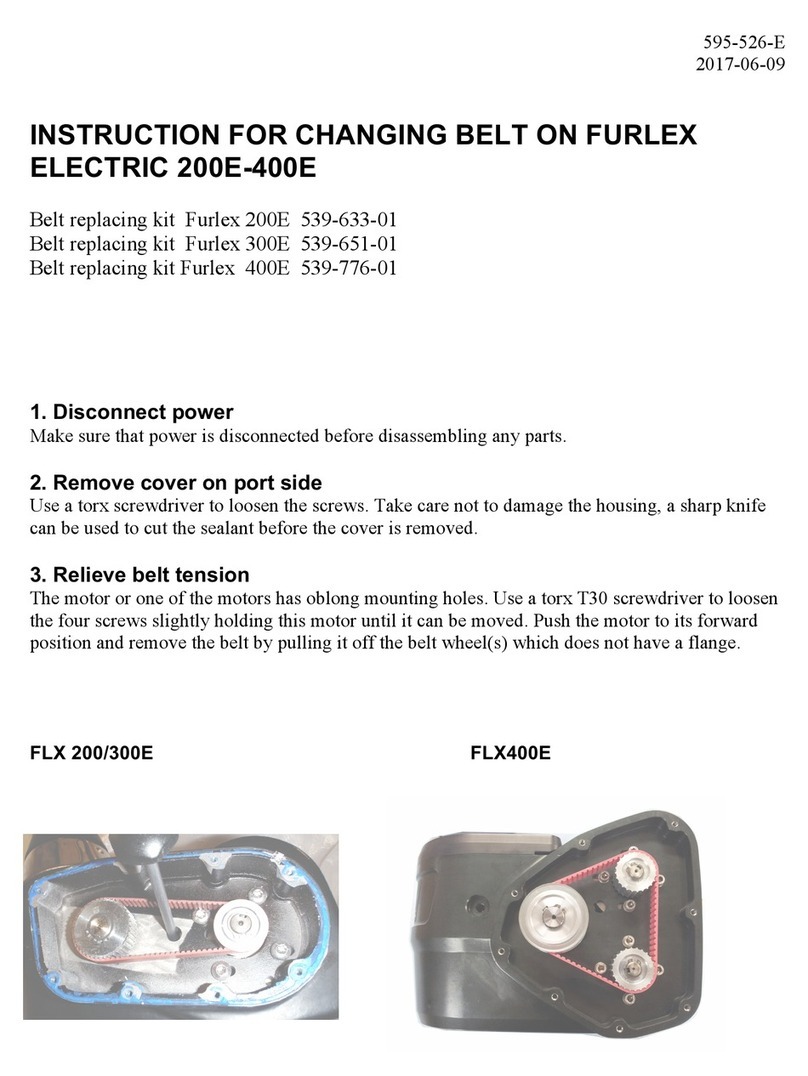Selden Furlex 404S Guide

1
Manual and Spare parts list
Furlex
404S
597-181-E
2016-03-03
404S

2
Contents
Page
1 Introduction
1.1. Key features 3
1.2. What’s included? 4
1.3. Main dimensions 4
1.4. Safety precautions 5
1.5. Sail information 6
2 Assembly preparations
2.1. Tools 7
2.2. Mast and deck attachment 7
2.3. Wire length calculation 8
2.4. Top extrusion length calculation 9
3 Assembly
3.1. Luff assembly 11
3.2. Fitting sta-lok wire terminal 13
3.3. Fitting eye terminal to swaged stud 15
3.4. Fitting lower eye terminal to rod stay 16
3.5. Drum unit assembly 17
4 Installation
4.1. Mast attachment 18
4.2. Deck attachment 19
4.3. Installation on a stepped mast 20
4.4. Installation on an un-stepped mast 20
4.5. Adjusting the forestay length 20
4.6. Furling line installation 22
4.7. Check list 23
5 Operation
5.1. Hoisting 24
5.2 Unfurling the sail 25
5.3 Furling the sail 25
5.4 Reefing 26
5.5 Racing 26
6 Maintainence
6.1. Inspection 27
6.2. Service 27
6.3. Storage 27
6.4. Dismantling 28
6.5. Trouble shooting 32
6.6. Spares and accessories 34
6.7 Toggles & links 38
7 Warranty conditions 39

3
1 Introduction
1.1 Key features
Congratulations on the purchase of your new Furlex jib furling system. Furlex jib furlers have been engineered
and manufactured by Seldén Mast since 1983. The system has been continuously developed over the years and
we are now launching the fourth generation Furlex, the most sophisticated single line jib furling system so far.
Maximized luff length
The luff extrusion foil shape remains unchanged all the way down the furling unit. This allows the whole sail
to be furled in an even roll - right down to the tack of the sail. This is essential to acheive an efcient sail shape
when the sail is reefed.
Load distributors
The patented load distribution technology of the Furlex system disributes loads over the entire ball race.
This reduces friction, provides smoother furling and considerably reduces bearing wear.
Compact halyard swivel
The all new halyard swivel design uses an HMPE textile loop that allows the halyard load to act in the centre of
the swivel instead of pulling on an offset eye. This reduces bearing loads and minimizes any wobbling tenden-
cies.
Low torque tack ring
The tack ring ”free turn” allows for the luff to be furled one turn before the tack. This makes for a atter and
more efcient sail shape when the sail is reefed. Reduced tack ring diameter in combination with a low prole
shackle – or an optional soft shackle – reduces the amount of effort needed to furl in that rst turn compared to
earlier models.
Soft shackle ready
The tack ring and halyard swivel eyes are prepared for using textile loops. All surfaces are smooth and nicely
rounded.
Aero grooves
Similar to the dimples on a golf ball, the Furlex AERO groove system reduces drag and creates better aero-
dynamic ow around the luff extrusion.
Third bearing
By the addition of a third roller bearing between the main ball bearings of the drum unit, the load from the
furling line is distributed over a large bearing area, reducing furling friction even further compared to earlier
models.
Floating connectors
The 316 stainless steel connectors are subjected to vertical loads only and no torsional loads. Torsional loads
are now taken by the join pieces alone which leaves the connectors “oating” inside the join thus reducing wear
inside the joins.
Air gaps
Every join in the system is made with a nominal gap which means the extrusion ends will never get in contact
with each other. This way there will be minimum chafe and no aluminum deposits staining on your new sail.
Jaw lock
Double screws through the rope and locking jaws ensure a bullet proof locking of the furling line.
Mobile swivels
Both the halyard swivel and the drum unit can be easily removed from the foil for off-season storage.
This facilitates storing the foil with the mast and makes handling easier.

4
TED
TET
DD
DW DH
HO
Basic pack / Extended pack Foil pack Wire pack / Eye pack
• Drum unit
• Halyard swivel
• Furling rope
• Bearing halves
• Top guard
• Sail feeder
• Manual
Extended pack also includes:
• Halyard leads
• Stanchion blocks
• Pre-feeder pack
• Torx bit set
• Luff extrusions
• Distance tubes
• Joining sleeves
• Connecting plates
• Wire with swaged eye
• Eye terminal (with or
without rigging screw)
Basic pack / Extended pack
The Furlex system consists of a basic pack with drum unit, halyard swivel, sail feeder, bearing halves, top guard
and furling rope. The Extended pack also includes halyard leads, stanchion blocks and pre-feeder pack -
accessories that will make your system work even better on your boat.
Foil pack, wire pack and eye pack
The Furlex system also includes a foil pack with luff extrusions, distance tubes and connectors. A complete
forestay is also supplied with every Furlex, including a swaged stud/eye solution (no adjuster) or a Sta-Lok
eye terminal tting with or without rigging screw. On new boats delivered with a complete new Seldén rig, the
forestay is usually included in the standing rigging and does not come as a separate wire pack. Rod stays are
supplied seperately by the rod manufacturer.
1.2 What’s included?
Wire dim. DD DH DW HO Clevis pin TED TET
12 mm
(15/32”)
Ø205
(8 5/64”)
170
(6 11/16”)
135
(5 15/16”)
100
(3 15/16”)
Ø19
(3/4”)
Ø19.5
(49/64”)
Ø16
(5/8”)
14 mm
(35/64”)
Ø205
(8 5/64”)
188
(7 13/32”)
135
(5 5/16”)
117
(4 39/64”)
Ø22
(55/64”)
Ø23
(29/32”)
Ø17
(43/64”)
All dimensions are given in millimeters and inches.
1.3 Main dimensions
Fig. 1.4.b
Fig. 1.4.a
Pin

5
15-20°
The information in this manual must be followed carefully to
avoid damage to the system and to aviod the risk of personal
injury. The warranty is only valid if the system is assembled and
operated according to this manual.
Please read the entire manual before assembly!
• Be very careful when you open the wire coil! It may spring
open and cause damage and/or personal injury.
• Never use a snap shackle to secure the standing rigging, not
even temporarily. When installing the system on a rigged
boat, always use a strong screw pin shackle or tie the
spinnaker halyard to a strong point on the boat before
removing the existing forestay.
• Incorrect halyard routing can result in ”halyard wrap” which
may cause severe damage to the forestay, and put the entire
rig at risk. The angle between the halyard and the forestay
must never be less than 15°. Incorrect halyard routing can
also cause the halyard shackle to wear agains the luff
extrusion.
• If using a winch for the furling line, rst check that there is
no obstruction which may interrupt the furling operation and
possibly cause damage.
• Take care to ensure that all split pins are secured properly
after installation.
1.4 Safety precautions
Fig. 1.3.cFig. 1.3.b
Fig. 1.3.d
Fig. 1.3.a
May lead to
Incorrect halyard routing can result in ”halyard wrap” which may cause severe
damage to the forestay, and put the entire rig at risk. The angle between the halyard
and the forestay must never be less than 15°!

6
FL
1100 mm
CB
E
F
Furlex type 404S
Head deduction F 630
(24 51/64”)
Tack deduction E
(Any additional toggle or link
must be added to E)
Ø 12: 390 (15 23/64”)
Ø 14: 410 (16 9/64”)
Cutback CB 80 (3 5/32”)
Internal diameter of luff groove
DLG
Ø 8
(5/16”)
Width of luff groove WLG 3.0 (1/8”)
Overall luff extrusion
dimensions
52 x 38
(2 3/64” x 1 1/2”)
Your sailmaker has all the necessary sailmaker information through the Seldén Sailmakers Guide.
The Sailmakers Guide can be downloaded from www.seldenmast.com
Note that if you want to use an existing sail, it will need some modications:.
• The luff length needs to be adjusted.
• A luff tape is required. The luff tape must be compatible with the Furlex luff extrusion geometry.
• Use webbing loops at the sail head and tack instead of grommets (cringles). The sail will then form tightly
round the luff extrusion when furling, and achieve a better shape when reefed.
1.5 Sail information
Fig. 1.5.a
Fig. 1.5.c
It is most important that the halyard swivel is located so that the halyard satises the 15–20°
angle requirement. If the sail prevents the swivel from reaching the correct position, the luff
length needs to be adjusted:
IF THE SAIL IS TOO LONG: Shorten the sail, e.g. in conjunction with changing to a luff
tape compatible with Furlex.
IF THE SAIL IS TOO SHORT: Lengthen the sail by means of a HMPE or wire pendant
tted to the head of the sail. Attach the pendant directly to the sail to prevent unintentional
removal, loss or exchange.
Fig. 1.5.b
WLG
DLG
Max sailspace FL -(F+E)

7
2 Assembly preparations
2.1. Tools
2.2 Mast and deck attachment
Before starting with the assembly, make sure you have the following tools available:
• Socket screw driver
• Hack saw
• Torx bits
• Measuring tape
• Knife
• Hammer
• Pencil
If Sta-lok is to be tted you will also need:
• Two adjustable spanners
• Polygrip
• Tape
• File
• Locking adhesive (included in the eye tting pack)
Always make sure that the forestay can articulate in all directions, both in the top and at deck level. Toggles
must be used in most cases to ensure sufcient articulation.
The toggle on the furling unit should always be tted directly to the chain plate. If the unit is to be tted below
deck or if it needs to be raised, an extension toggle can be used but always make sure that the toggle that
comes with the drum unit is attached to the chain plate.
See chapter 4 for further information.
For available toggles and extension links, see chapter 6.7 “Toggles & links”.
Fig. 2.2.a
Fig. 2.2.d Fig. 2.2.e Fig. 2.2.f
Fig. 2.2.b Fig. 2.2.c

8
2.3 Wire length calculation
1. Slacken the backstay and/or the cap shrouds as much as possible, but make sure that no rigging screws are
unscrewed so far that the threads are no longer visible ”on the inside” of the rigging screw body. Ideally the
forestay setting should not be adjusted. However, if there is insufcient adjustment in the backstay, and the
forestay has a rigging screw, this can be adjusted as well. Just make sure to mark the thread with tape before
adjusting.
2. Pull the top of the mast forward using the genoa or spinnaker halyard. Secure the halyard using a ”D”
shackle or tie the halyard to a strong deck tting. For safety reasons, do not use any halyard snap shackles.
Secure the halyard tail after the halyard has been tensioned.
3. Go up the mast. Connect a free halyard to the forestay. Then detach the forestay and lower it using the free
halyard. Bring the stay down and place it on a at surface. If the forestay rigging screw was slackened,
adjust it back to the tape mark.
4. Measure the forestay length (FL) with just enough tension to keep the forestay straight on the ground.
Forestay length (FL) is the distance between the hole in the swaged top terminal and the hole in whatever
lower part that was attached directly to the hole in the chain plate. Enter the measurement into ”Table 1”
below, in the row marked FL.
Table 1: Calculation of forestay wire cutting length Your
forestay
Example
(404S/Ø12)
with rigging screw
50% extended
FL Existing forestay length (FL), including rigging screw (See Fig. 2.4.a) 9500
TDeduction for lower terminal: - - 280
HIf links or extra toggles are to be used, deduct this length (H) from FL.
(See table 6.7).
- - 0
WL Cutting measurement. The new forestay wire is to be marked at this point.
(For stays with swaged stud, WL equals the length of the nished stay as
shown in g 4.2.a. and NOT the cutting length)
= = 9220
If a Sta-lok terminal (with or without rigging screw) is included, the wire is supplied over-length. The wire has
a swaged eye terminal on one end while the other end is open (= without terminal). If your Furlex is supplied
with a xed-length forestay, with a swaged eye on one end and a swaged stud in the other end, skip this part
and go directly to 2.4. The same apply for rod stays.
If a stud-terminated stay is to be manufactured by a local rigger it is important to note that WL in this case
equals the length of the nished stay, from eye to end of stud, as shown in g. 2.4.a. WL is calculated in table 1.
Before assembly, an over-length wire (for Sta-lok) must be marked and nally cut to the correct length to t
the boat’s actual forestay length. To nd out the correct measurement, follow the steps below. If the mast is not
stepped, you can jump directly to step 4.
You can use the FURLEX CALCULATOR on our web site. Go directly to the calculator by
scanning the QR-code with your mobile device or visit www.seldenmast.com.
WIRE Without rigging screw: With rigging screw:
404S Ø 12 mm wire: 140 mm (5 33/64”)
Ø 14 mm wire: 155 mm (6 7/64”)
Ø 12 mm wire: 280 mm (11 1/32”)
Ø 14 mm wire: 285 mm (11 7/32”)
ROD Without rigging screw: With rigging screw:
404S Rod -30: 140 mm (5 33/64”)
Rod -40: 155 mm (6 7/64”)
Rod -30: 280 mm (11 1/32”)
Rod -40: 285 mm (11 7/32”)

9
A
E
300
CB
D
WL T
2.4 Top extrusions - length calculation
The Furlex luff extrusion consists of a number of shorter pieces. Starting from the bottom there is a 1000 mm
(39 3/8”) luff extrusion connected to the drum unit and extending up to the sail feeder. Then, from the sail
feeder and up there are a number of full length luff extrusions (L=2400 mm) and nally there is a top extrusion
that has to be cut to length to suite the actual forestay length.
Note! If the calculation gives a top extrusion length (D) that is shorter than 400 mm
(15 3/4”), the calculation must be reworked by exchanging one of the 2400 mm (94 1/2”)
extrusions with the uncut 1700 mm (67”) top extrusion. By doing so the top extrusion will be
cut from a 2400 mm (94 1/2”) length and its length will then exceed 400 mm (15 3/4”). If the
calculation gives a top extrusion length (D) that exceedes 1700 mm (67”), the top extrusion
must be cut from one of the 2400 mm (94 1/2”) extrusions. In this case the 1700 mm (67”)
extrusion will not be used.
Fig. 2.4.a
FL = existing forestay length

10
To nd out the cutting length of the top extrusion (D) and the length of the top distance
tube (E), start with the length of the forestay wire (WL) that was calculated in table 1. Then
follow the steps in table 2 below. On xed length forestays (incl. rod stays), verify WL by
measuring the stay length from centre of eye to end of stud (wire) or end of rod head.
You can also use the FURLEX CALCULATOR on our web site. Go directly to the calculator
by scanning the QR-code with your mobile device.
Table 2: Calculation of top luff extrusion length and top distance tube length Your forestay
Example
(404S/Ø12)
with rigging screw
50% extended
WL Length of the new forestay wire (as per Table 1). 9220
A+B 1330
NNumber of full length extrusions to be used:
N = ( WL - (A+B) ) / 2400 (94 1/2”)
(9920-1330)
/2400=3.3
N=3
CTotal length of the number of full length extrusions (2400 mm) to be used:
C = N x 2400 94 1/2”)
3 x 2400 =
7200
D* Length of top luff extrusion:
D = WL – (A+B) – C
9920-1330
-7200 = 690
E* Length of the top distance tube:
E=D-300 (11 13/16”)
690-300 =
390
*) If, as in our example, D becomes less than 400 mm it is necessary to recalculate as below and cut one of the
full length luff extrusions according to Dnew and one of the full length distance tubes according to Enew.
Note that the original top luff extrusion and the original top distance tube will now be used as intermediate
extrusions.
Table 2B: Recalculation if D<700 mm Your forestay Example
Nnew Reduce the number of full length extrusions by one.
Nnew = N-1
N=2
Cnew Cnew = Nnew x 2400 + 2000 (94 1/2” + 78 47/64”) 2 x 2400 +
1700 = 6500
Dnew Dnew = D + 400 (15 3/4”) 690 + 700 =
1390
Enew Enew = E + 400 (15 3/4”) 390 + 700 =
1090
WIRE Without rigging screw: With rigging screw:
404S Ø12 mm wire: 1470 mm (57 7/8”)
Ø14 mm wire: 1550 mm (61 1/32”)
Ø12 mm wire: 1330 mm (52 23/64”)
Ø14 mm wire: 1420 mm (55 29/32”)
ROD Without rigging screw: With rigging screw:
404S Rod -30: 1470 mm (57 7/8”)
Rod -40: 1490 mm (58 21/32”)
Rod -30: 1380 mm (54 21/64”)
Rod -40: 1420 mm (55 29/32”)

11
1. Stretch out the wire on a at, clean surface. On stays with swaged lower terminal, be careful not to
damage the terminal thread. The thread can be protected with tape or similar.
2. Start by feeding the top luff extrusion and the top distance tube onto the forestay wire.
Make sure that the cut end of the top luff extrusion is up (hole down). with distance
tubes are welded shut but are easily opened by hand. Note the correct
orientation of the distance tube - hinge to be sideways.
3. Add a short joining sleeve and use it to push the distance tube up into the top luff extrusion. The
distance tube should be pushed in approximately half the length of a joining sleeve.
4. On Sta-lok terminated systems, the halyard swivel and the top guard can be tted at this point, see
below. On stud terminated systems, the top guard must be tted after the sail feeder has been mounted.
5. Add another luff extrusion and another distance tube. Make sure the distance tube is oriented correctly.
Also add another short joining sleeve.
6. Fit a short connecting plate into the second luff extrusion as shown. Push the rst joining sleeve down
into the second luff extrusion to lock the connector.
7. Connect the two luff extrusions.
8. Push the rst joining sleeve back up into the rst luff extrusion to lock the join. Use the second joining
sleeve to push on the second distance tube. The second distance tube should be pushed in approximately
half the length of a joining sleeve. This will ensure correct location of the rst joining sleeve.
3 Assembly
3.1 Luff assembly
Luff assembly should be carried out on a clean, at surface. Make sure there is enough space for the entire
forestay length to be stretched out.
At this point the top luff section and the top distance tube should be cut to length according to table 2.
Notethattheluffextrusionsarettedontothewire,whereasonpreviousmodelsthewirewas
ttedasalaststep.Alsonotethattheluffisassembledfromtopdownasopposedtoolder
Furlex systems, see instruction 597-184-E.
Fig. 3.1.a
Fig. 3.1.c
Fig. 3.1.d
Fig. 3.1.e
Fig. 3.1.b

12
9. Repeat for the remaining 2400 mm (94 1/2”) luff extrusions. Use short joining sleeves only.
10. Fit the long joining sleeve onto the wire with two-hole end downwards. Then t the 1000 mm (39 3/8”)
luff extrusion with two-hole end downwards. Fit the long connecting plate to the 1000 mm (39 3/8”)
extrusion and push the joining sleeve upwards to hold it in position. Connect to the upper extrusion
and push up the joining sleeve. Make sure that the holes in the lower part of luff extrusion and join are
perfectly aligned.
11. Fit the two grub screws in the connecting plate with locking adhesive. This will lock the distance tube
in position. make sure that the holes in the lower part of extrusion/join are aligned and tighten the
screws rmly.
12. Snap on the sail feeder connector and put the sail feeder in position. Push the sail fedder upwards and
secure with the screw. Tighten moderately.
13. Fit the halyard swivel from the top and slide it down until it stops on top of the sail feeder. Then t
the top guard and push it into the top luff extrusion until it stops. Secure it with the four pre-tted
screws. Tighten the screws until they bottom, but do not over-tighten.
14. Fit the bearing plug halves and push them up ito the long joining sleeve. Adjust so that the hole in the
forward bearing plug aligns with the forward hole in the luff extrusion/join.
15. The bearing halves should be a tight t in the join extrusion.
You may need to grind the sides of the aft bearing half slightly
with a le or a knife to get the correct t.
This completes the luff assembly. Next step is to t the lower eye teminal to the stay. There are two types of eye
terminals; Stud/Eye terminal and Sta-lok eye terminal (with or without rigging screw).
Fig. 3.1.n
Fig. 3.1.m
Fig. 3.1.l
Fig. 3.1.o
Fig. 3.1.r
Fig. 3.1.p
Fig. 3.1.s
Fig. 3.1.q
Fig. 3.1.t
Fig. 3.1.f
Fig. 3.1.i
Fig. 3.1.g
Fig. 3.1.j
Fig. 3.1.h
Fig. 3.1.k

13
2 mm
WL
1.
Before cutting the wire, measure the wire from the centre of the hole in the top swaged eye terminal. Mark the
measurement WL carefully on the wire using a marker pen. (The WL measurement was calculated in ”Table
1”, (Chapter 2.3).
2. Put adhesive tape around the wire on both sides of the cutting mark to assist cutting. Carefully cut the
wire using a hacksaw.
3 .
Unscrew the socket, wedge and former from the terminal part (or Furlex rigging screw if to be used).
4.
Thread the socket onto the wire.
5.
Slide the wedge over the core (7 strands) of the wire. The core of the wire should protrude approx. 2 mm
(5/64”) from the wedge.
3.2 Fitting Sta-lok eye terminal
Note! For systems with swaged stud terminal, skip this part and go directly to 3.3.
Fig. 3.2.b
Fig. 3.2.c
Former Wedge Socket
Terminal part (or rigging screw)
Fig. 3.2.d
Fig. 3.2.a

14
6 .
Space the outer strands of the wire evenly around the wedge and bring
down the socket so that the strands are held in place. Hold an adjustable
spanner between the 1000 mm (39 3/8”) extrusion and the socket. Tapping
the core of the wire, locate it firmly in the socket.
Check that the core of the wire protrudes approx. 2 mm (5/64”) from the
wedge. See fig. 3.2.d.
7.
Bend the outer strands inwards a little using a pair of pliers, or tap the
strands with a small hammer. In the latter case, rest the socket’s thread
on a soft surface (wood or similar) to prevent damage.
8.
Insert the former into the threaded hole of the terminal part (or rigging screw). Lubricate the socket´s thread
with a long bead of locking adhesive. Screw the terminal part onto the socket and tighten carefully, forcing
the wire further into the terminal.
9.
Unscrew and check that the outer strands are evenly
distributed around the wedge. If some strands are
crossed, correct their positions.
10.
If assembly is unsuccessful and needs to be repeated, refer to the relevant parts of chapter 6.4
”Dismantling”.
11.
Apply another 2 or 3 drops of the locking adhesive to the
thread and screw the terminal together, tightening it firmly.
The terminal is now permanently locked.
NOTE! Check that no strands slip into the slot of the wedge.
Fig. 3.2.e
Fig. 3.2.h
Fig. 3.2.g
Fig. 3.2.f
NOTE! Check that no strand has slipped into the slot of the wedge!

15
3.3 Fitting eye terminal to swaged stud (Stud/Eye)
1. Remove the toggle from the eye fitting.
2. Screw the eye terminal part onto the stud terminal until the holes in stud and eye align.
3. Fit the spirol spring pin using a hammer to permanently lock the terminal.
3.4 Fitting lower eye terminal to rod stay
1. Screw out the socket on the lower terminal part and remove the wedge and the former. These three
parts are not to be used in rod application.
2. Add 2-3 drops of locking adhesive on the thread and screw the terminal together. Check that the rod
head sits correctly in the seat and that the seat sits correctly in the socket.
3. Tighten firmly for permanent locking.
Fig. 3.3.a
Fig. 3.3.b
Fig. 3.3.c
Fig. 3.4.a
Fig. 3.4.b

16
20°
3.5 Drum unit assembly
1. Unscrew the two screws holding the adaptor halves together. Take care not to loose the screws.
2. Remove the clevis pin that goes through the tube shaft in the drum unit.
3. Fit the drum unit over the eye terminal. Orient the drum unit so that the at surface on the eye
terminal meets the two ribs inside the drum unit tube shaft.
If a Furlex rigging screw is used, the at faces on all three components must be aligned. As the two
ribs on the inside of the tube shaft matches the at faces, it will securely lock the rigging screw.
When tting the drum unit, the rigging screw should be unscrewed halfways.
Ret the clevis pin through the tube shaft and the hole in the eye terminal. Secure with the split pin.
Fig. 3.5.a
Fig. 3.5.b
Fig. 3.5.eFig. 3.5.dFig. 3.5.c

17
20°
5. Fit the adaptor halves. The round steel bosses in the adaptor halves t into the holes in the luff extru-
sion lower end. Note that the halves can be tted one way only; make sure that the small knob in the
upper hub ts into the front adaptor half.
Best practice to t the adaptor halves is to start by pushing the forward adaptor half onto the luff
section (1) and then connect to the upper hub (2). When the forward half is in postion, t the aft half
(3) and click the halves together. Make sure that the screws go in smoothly so that the screw threads
are not damaged.
Tighten the screws rmly.
6. Ret the toggle. Secure the split pin.
4. Turn the drum unit so that the small knob in the upper hub is oriented as shown in relation to the luff
extrusion. The knob should be pointing in the same direction as the foil to t correctly into the
forward adaptor half.
Knob
Fig. 3.5.f
Fig. 3.5.g
Fig. 3.5.i
Fig. 3.5.h

18
0–15°
15–20°
4.1 Mast attachment
4.1.1 Halyard routing
The guiding principle for tting the Furlex to the mast is that the forestay connection should allow sufcient
articulation in all directions. In most cases a toggle must be tted between the Furlex stay and the forestay
attachment. For available toggles and extension links, see chapter 6.7 “Toggles & links”.
The angle between the halyard and the forestay must be at least 15°. If the
angle is less than 15°, the halyard may wrap around the luff extrusion when
the sail is being furled, possibly damaging the halyard and the luff extrusion.
Failure to observe what is happening in this situation may even result in
damage to the forestay wire.
Before installing the Furlex on the boat, make sure that the 15-20° require-
ment is fullled. On new Seldén masts this is usually not an issue but on older
masts - or masts of other brands - it may be necessary to t halyard leads or to
t a new halyard box.
The Extended Pack includes two halyard leads. These are easy to install and
t on most mast brands. Halyard leads should be inspected once a year and
any sharp edges smoothed with a le. The halyard lead should be replaced
when wear reaches 50%.
Alternatively, a sheave box can be tted to the mast to meet the 15-20°
requirement. Installation is more complicated but the box will eliminate the
need to replace the halyard leads as they wear. Sheave box kits (with assembly
instructions) can be obtained from your Seldén dealer.
If the boat is equipped with a spinnaker halyard, this must be kept clear of the
Furlex-system when not in use to avoid halyard wrap. An effective solution
is to lead the halyard around the upper shroud and then down aft of the
spreaders.
4 Installation
Installation of the Furlex system on the boat requires a minimum of two persons, however it is recommended to
be at least three persons to do the job more easily.
Fig. 4.1.1.a
Fig. 4.1.1.b

19
4.2 Deck attachment
4.2.1 Attachment below deck
The lower end of the Furlex-system comes with a fork toggle as
standard. This can normally be attached directly to the boat’s
forestay tting at the stemhead. Check that the drum unit does not
interfere with the pulpit, navigation lights or other deck ttings.
If the boat is tted with a bow anchor, it may be necessary to
permanently raise the drum unit to give the crew sufcient space for
anchor work.
If the drum unit is raised by means of an extension link, a toggle
must be tted between the link and the boat’s forestay attachment at
the stemhead.
For available toggles and extension links, see chapter 6.7 “Toggles
& links”.
The furling unit can be tted below deck inside an anchor well. The
advantage is that the sail’s luff length is maximized and the access around
the forestay is improved. The disadvantage is a more complicated route
for the furling line resulting in increased furling resistance. The diagrams
below illustrate various methods of installation.
For the furling line to be wound evenly onto the line drum, the rst
turning point (stanchion block) must be at least 300 mm (11 13/16”) away.
The tack should be located as close to deck level as possible. Regardless of
which option is chosen, the Furlex-system must always be kept clear of the
deck well’s inside surfaces.
Avoid routing the line through an integral deck conduit, as this will
increase the friction on the furling line.
Use a large ball bearing block to minimize friction losses.
The anchor well must be well drained.
If the Furlex is tted above deck, but with the forestay tting in the
anchor well, a Furlex extension toggle can be used. For larger distances,
use a custom made stainless steel bar or rod stay. For available toggles and
extension links, see chapter 6.7 “Toggles & links”.
Min. 300 mm
Fig. 4.2
Fig. 4.2.1.a
Fig. 4.2.1.b
Min. 300 mm

20
4.3 Installation on a stepped mast
4.4 Installation on an un-stepped mast
1. Lay the dressed mast on trestles with the front facing up.
2. Connect the top end of the Furlex-system to the forestay attachment on the mast. Make sure that the stay is
free to move in all directions.
3. Lift the mast in the crane with the Furlex-system lying on the leading edge of the mast.
4. Have one person watching the Furlex-system to ensure that it does not get caught when lifting the mast.
5. Keep the end of the stay outside the deck area in order to avoid damage.
6. Attach the stay to the chain plate in the boat at the stemhead. Make sure that the stay is free to move in all
directions.
Fig. 4.3
4.5 Furling line installation
The furling line is best tted to the drum unit with cover and line guide removed.
1. Start by loosening the screw on the underside of the drum unit a few turns. Then loosen the two smaller
screws on each side of the line guide tting until the line guide tting and cover seperates. Remove the line
guide tting. It may be necessary to loosen the screw on the underside a few extra turns for the line guide
tting to come off.
2. Pull out the lock block.
3. Remove the cover.
4.5.1 Removing line guide fitting and cover
Fig. 4.5.1.a Fig. 4.5.1.b Fig. 4.5.1.c
1. Slacken the backstay as much as possible, but do not remove it.
2. Pull the mast forward using a genoa halyard or a spinnaker halyard. Secure the halyard to a strong deck
tting using a screw pin shackle or tie the halyard to a strong deck tting. For safety reasons, do not use
snap shackles.
3. Tie a strong, not too stiff, rope around the luff extrusion. Make two clove hitches and tape the knots over
carefully so that they cannot slide.
4. Hoist the stay using a spare halyard.
5. ”Go aloft” and attach the top end of the Furlex-
system to the forestay attachment. Always use a
proper bosun’s chair. If there are no free headsail
halyards, use the main halyard. For further information,
see the ”Working aloft” chapter in the brochure
”Hints and Advice” that can be downloaded from
www.seldenmast.com.
6. Finally attach the stay to the forestay attachment in the boat at the stemhead.
Table of contents
Other Selden Marine Equipment manuals
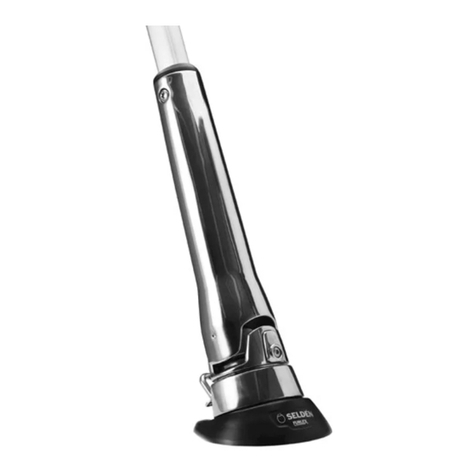
Selden
Selden Furlex 204TD User manual
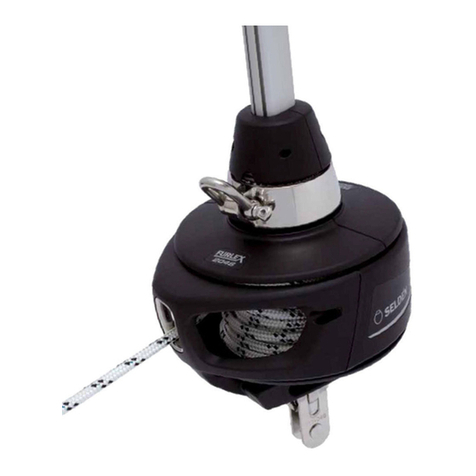
Selden
Selden Furlex 104S Guide

Selden
Selden Furlex 200 S User manual
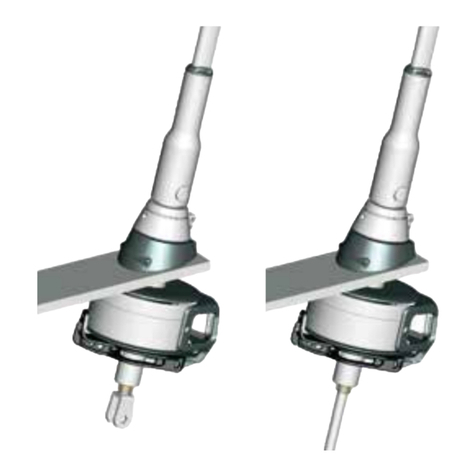
Selden
Selden Furlex 200 TD User manual
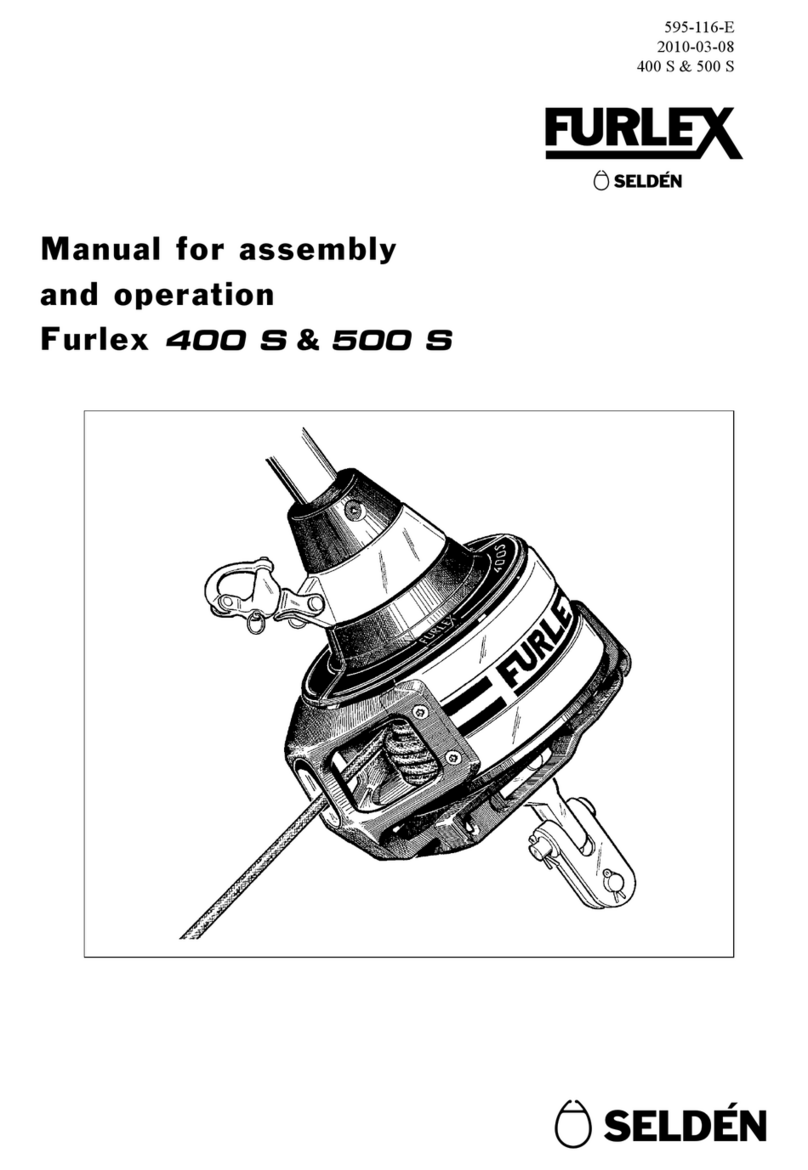
Selden
Selden Furlex 400 S Supplement

Selden
Selden Furlex Electric 200E User manual
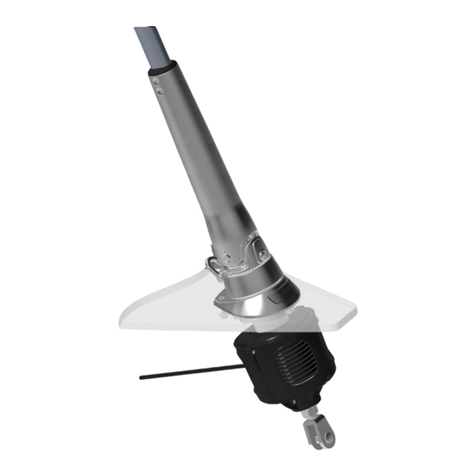
Selden
Selden Furlex 404TD Guide
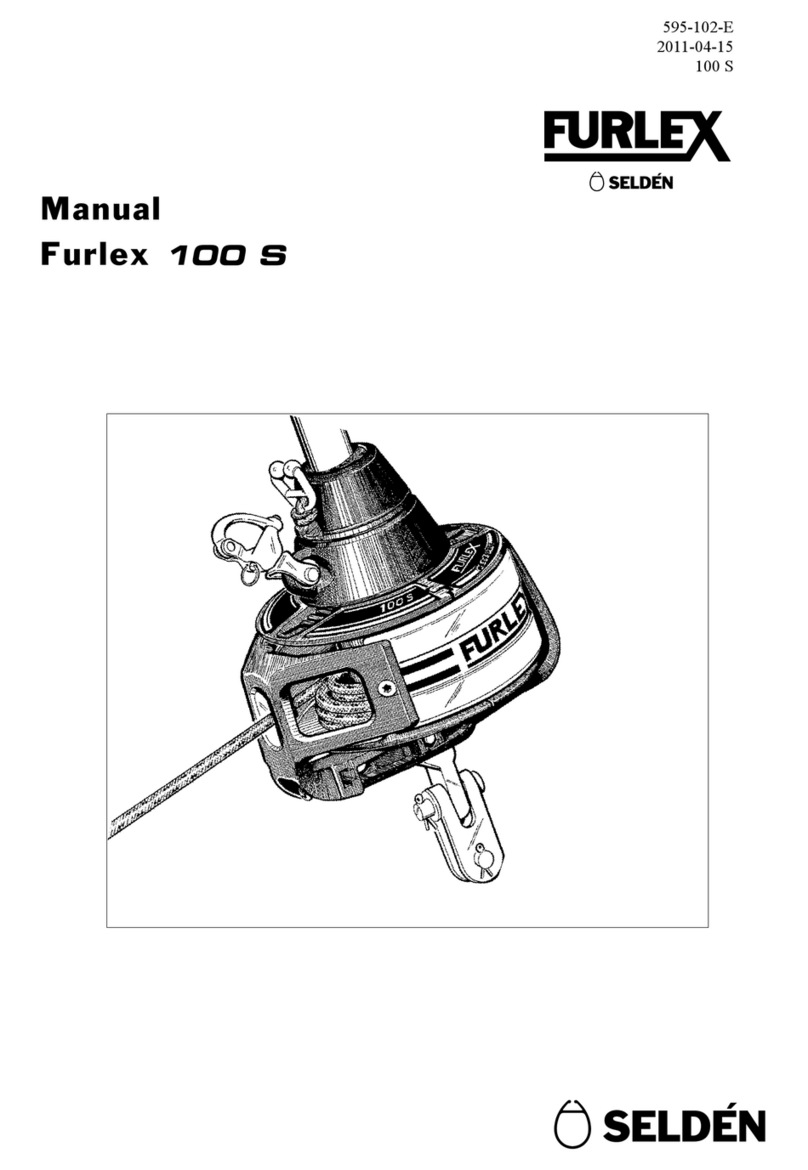
Selden
Selden Furlex 100 S User manual

Selden
Selden Furlex 204S Guide
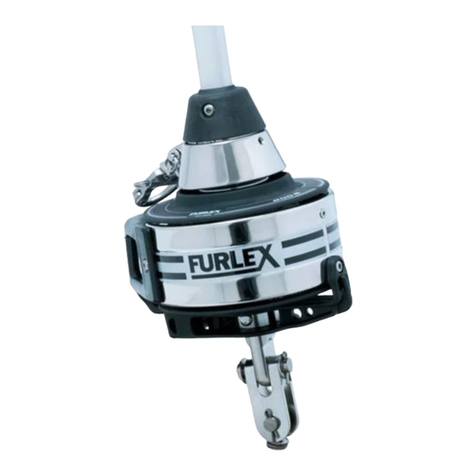
Selden
Selden Furlex 200 S User manual
